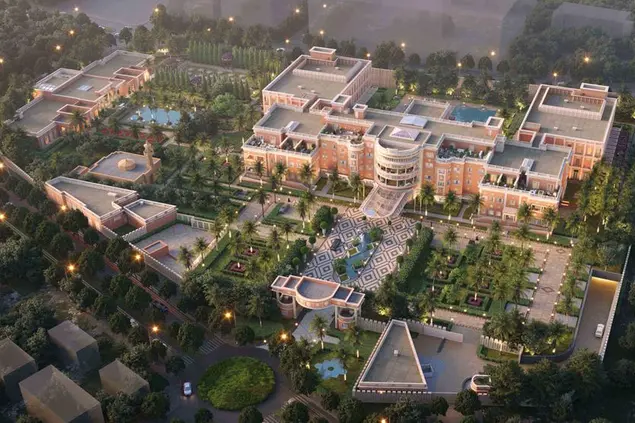PHOTO
Built in 1943 by the Kingdom’s founding father King Abdulaziz for his son, Crown Prince Saud, The Red Palace holds an important place in the memory and history of Saudi Arabia.
Located in the historic Al-Futah district in the heart of old Riyadh, it was the first reinforced concrete structure to be built in Riyadh, marking a significant milestone in the Kingdom’s architectural journey.
Throughout its illustrious past, The Red Palace hosted international receptions and royal banquets, welcoming heads of state, government officials, and other prominent figures. Later, it served as the Council of Ministers' headquarters for over three decades and housed the Court of Grievances until 2002.
More recently, the landmark was acquired by Boutique Group, a hospitality company invested in promoting Saudi Arabian heritage and preserving historic and cultural properties. In 2022, Aedas Middle East, the regional office of the global award-winning architecture and design firm Aedas, won a highly contested design competition to reimagine this historical structure into an ultra-luxury boutique hotel, fusing the past with the future to re-establish The Red Palace as a global icon that celebrates the history and splendour of a bygone era.
The team at Aedas, led by Global Design Principal Igancio Gomez will work in close partnership with Paris-based Tristan Auer, an interior and emotion architect with a rich aesthetic vision, to reimagine and expand the property to offer more than 70 keys, 8 spa suites, and 5 high-end restaurants and cafes.
The Vision
With a remodelling vision ‘to time travel and create a window into the past’ where international travellers can experience a seamless blend of golden age charm with contemporary elegance. To keep an imprint of its origin, the main palace and the historic mosque within the premises will be retained and refurbished. New constructions will include Annexes to the main structure along with a Spa and Wellness Centre, water features, outdoor pool, courtyards and landscaped royal gardens.
Ignacio says: “Our design aims not to simply recreate a physical space but rather to evoke a sense of time, specifically the solemnity and grandeur associated with the emotional importance of the Kingdom's history and its future vision. We want to create an experience that would transport visitors to a different era, immersing them in the rich heritage of the palace while also reflecting its significance in the present and future.”
A Grand Entrance
The Approach
The entrance into the ultra-luxury Boutique Hotel will be via a majestic colonnade portal. A landscaped royal garden will greet visitors on their drive down to the porte cochère of the palace building, creating a sense of arrival and setting the mood for the experience that awaits inside.
The outdoor space is designed to carry the memory and grandeur of the past, while the landscaping, an extension of the architecture, serves to slowly unfold the palatial experience.
A Fusion of Najdi Architecture and Art Deco
The façade is a case of vernacular meeting modern – a fine and surprising blend of Najdi architecture and Art Deco style. The muted red terracotta plastered concrete, the colour that gives the palace its name, is an interpretation of the traditional mud plastering of yore, while the cornice mouldings, composite columns, decorative motifs and chevron patterns are elements drawn from Art Deco inspirations.
Significant emphasis is given to the design of new buildings and ensuring that they not only complement the existing structures but also seamlessly integrate with the surrounding landscape and royal grounds.
Details of the facade
Reflecting the Past and Designing for the Future
In developing the project, the team immersed in a detailed study of the existing architecture and its signature features to develop a design vocabulary for the new build. This base palette of traditional elements seamlessly intermingles with a fresh design language rich with innovations in glass and stone cladding and modern interpretations of classic elements.
The interior design concept that enforces The Red Palace as ‘an essential symbol of the history of King Saud and Saudi Arabia’ by respecting the palace’s heritage which providing a luxurious and contemporary experience for guests. It also introduces pleasures of hyper luxury through the use of rich woods dressed in precious marquetry and intricate flower patterns and sophisticated local artworks.
An unparalleled experience awaits visitors with world-class amenities right from the spa to the fitness centre, restaurants, event spaces and a taste of Saudi hospitality with a well-appointed private butler service.
A view of the interiors designed by Tristan Auer
The Red Palace boutique hotel, expected to be open to worldwide visitors by 2025, will be an authentic recreation of the past, with an exterior that reflects Saudi heritage and interiors designed in par with the most opulent resorts worldwide.
-Ends-
About Aedas
Aedas is the world’s only local and global architecture and design practice driven by global sharing of research, local knowledge and international practice. Our 1,200 creative minds with design studios across the globe create world-class design solutions with deep social and cultural understanding of the communities we design for. We create world-class design solutions that are tailored to the needs of cities and communities around the world.
www.aedas.com
